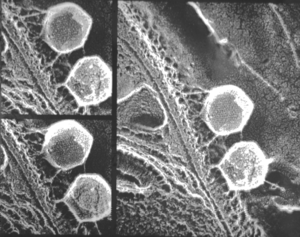Phycodnaviridae: Difference between revisions
No edit summary |
|||
| (15 intermediate revisions by 3 users not shown) | |||
| Line 1: | Line 1: | ||
[[Category:Short pages]] | |||
{{Curated}} | |||
{{Viral Biorealm Family}} | |||
[[Image:phycodna.gif|thumb|right|Phycodnaviridae. From [http://www.ncbi.nlm.nih.gov/ICTVdb/ICTVdB/51000000.htm ICTVdB Descriptions]]] | |||
==Baltimore Classification== | ==Baltimore Classification== | ||
| Line 7: | Line 13: | ||
===Genera=== | ===Genera=== | ||
''Chlorovirus'', ''Coccolithovirus'', ''Phaeovirus'', ''Prasinovirus'', ''Prymnesiovirus'', ''Raphidovirus'' | |||
==Description and Significance== | ==Description and Significance== | ||
Phycodnaviridae are viruses with double-stranded DNA that infect chlorella, algal symbionts of paramecia and hydras. | Phycodnaviridae are viruses with double-stranded DNA that infect chlorella, algal symbionts of paramecia and hydras. Members and prospective members of the family are large icosahedral viruses that infect eukaryotic algae. | ||
It is expected that the Phycodnaviridae will evolve into a large complex family or, more likely, split into a several families as new algal viruses are isolated and characterized. The reason for the complexity can be explained by a recent provocative paper that expanded the phylogenetic analysis and placed phycodnaviridae near the root of all eukaryotic DNA polymerases. | |||
So far, the genomes of two phycodnaviruses have been completely sequenced, a Paramecium bursaria Chlorella virus (PCBV-1) and an Ectocarpus siliculosus virus (EsV-1) and scientists are in the process of sequencing an E. huxleyi virus (EhV-86). The genomes of these three viruses have only nine genes in common, which is particularly surprising since they are all from the same virus family. | |||
==Genome Structure== | ==Genome Structure== | ||
The genome of phycodnaviridae is not segmented and contains a single molecule of linear double-stranded DNA. The complete genome is 250000-350000 nucleotides long. The genome guanine + cytosine content is 40-52 %. The genome contains unusual bases, varying from 0.1-47 %. These bases are 5-methyl deoxy-cytosine residues and N6-methyl deoxy-adenosine residues in some DNAs. The double-stranded DNA is non-permuted and the genome sequence has termini with cross-linked hairpin ends. The genome, except for the hairpin, has terminally redundant sequences. These sequences have inverted terminal repetitions (ITR) for at least 2000 bases. (source: [http://www.ncbi.nlm.nih.gov/ICTVdb/ICTVdB/index.htm ICTVdB Descriptions]) | |||
==Virion Structure of a Phycodnaviridae== | |||
The virions of phycodnaviridae consist of a non-enveloped capsid. The virion attaches to the host cell surface and releases DNA into the host cell in a similar fashion as Tectiviridae. The capsid is round and exhibits polyhedral symmetry. The isometric capsid has a diameter of 130-200 nm. The capsid shells of virions are composed of multiple layers and are referred to as multilaminated capsids. The capsids appear hexagonal in outline. (source: [http://www.ncbi.nlm.nih.gov/ICTVdb/ICTVdB/index.htm ICTVdB Descriptions]) | |||
==Reproduction Cycle of a Phycodnaviridae in a Host Cell== | ==Reproduction Cycle of a Phycodnaviridae in a Host Cell== | ||
| Line 26: | Line 38: | ||
==References== | ==References== | ||
Wilson, Willie; "Giant algal viruses: lubricating the great engines of planetary control"; <u>MICROBIOLOGY TODAY</u>; Volume 29, November 2002 | |||
Van Etten, J.L., Graves, M.V., Mueller, D.G., Boland, W., and Delaroque, N.; "Phycodnaviridae - large DNA algal viruses"; <u>Archives in Virology, 147</u>; 2002 | |||
[http://www.ncbi.nlm.nih.gov/ICTVdb/ICTVdB/index.htm ICTVdB Descriptions] | |||
Latest revision as of 19:49, 28 September 2015
A Viral Biorealm page on the family Phycodnaviridae

Baltimore Classification
Higher order taxa
Viruses; dsDNA viruses, no RNA stage; Phycodnaviridae
Genera
Chlorovirus, Coccolithovirus, Phaeovirus, Prasinovirus, Prymnesiovirus, Raphidovirus
Description and Significance
Phycodnaviridae are viruses with double-stranded DNA that infect chlorella, algal symbionts of paramecia and hydras. Members and prospective members of the family are large icosahedral viruses that infect eukaryotic algae.
It is expected that the Phycodnaviridae will evolve into a large complex family or, more likely, split into a several families as new algal viruses are isolated and characterized. The reason for the complexity can be explained by a recent provocative paper that expanded the phylogenetic analysis and placed phycodnaviridae near the root of all eukaryotic DNA polymerases.
So far, the genomes of two phycodnaviruses have been completely sequenced, a Paramecium bursaria Chlorella virus (PCBV-1) and an Ectocarpus siliculosus virus (EsV-1) and scientists are in the process of sequencing an E. huxleyi virus (EhV-86). The genomes of these three viruses have only nine genes in common, which is particularly surprising since they are all from the same virus family.
Genome Structure
The genome of phycodnaviridae is not segmented and contains a single molecule of linear double-stranded DNA. The complete genome is 250000-350000 nucleotides long. The genome guanine + cytosine content is 40-52 %. The genome contains unusual bases, varying from 0.1-47 %. These bases are 5-methyl deoxy-cytosine residues and N6-methyl deoxy-adenosine residues in some DNAs. The double-stranded DNA is non-permuted and the genome sequence has termini with cross-linked hairpin ends. The genome, except for the hairpin, has terminally redundant sequences. These sequences have inverted terminal repetitions (ITR) for at least 2000 bases. (source: ICTVdB Descriptions)
The virions of phycodnaviridae consist of a non-enveloped capsid. The virion attaches to the host cell surface and releases DNA into the host cell in a similar fashion as Tectiviridae. The capsid is round and exhibits polyhedral symmetry. The isometric capsid has a diameter of 130-200 nm. The capsid shells of virions are composed of multiple layers and are referred to as multilaminated capsids. The capsids appear hexagonal in outline. (source: ICTVdB Descriptions)
Viral Ecology & Pathology
References
Wilson, Willie; "Giant algal viruses: lubricating the great engines of planetary control"; MICROBIOLOGY TODAY; Volume 29, November 2002
Van Etten, J.L., Graves, M.V., Mueller, D.G., Boland, W., and Delaroque, N.; "Phycodnaviridae - large DNA algal viruses"; Archives in Virology, 147; 2002
